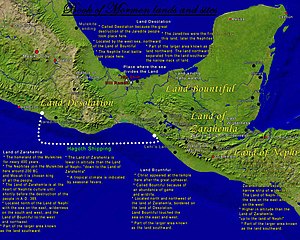Lehi-Nephi
This article uncritically uses texts from within a religion or faith system without referring to secondary sources that critically analyze them. (October 2011) (Learn how and when to remove this template message) |

In the Book of Mormon, the land of Lehi-Nephi (/ˈliːhaɪ
According to the Book of Mormon, the land of Nephi was south of and at higher elevation than Zarahemla.[8] A strip of wilderness running east and west divided the land of Nephi from the land of Zarahemla.[9]
In the 1st century BC, the lands of Nephi and Zarahemla were bordered on the east and on the west by bodies of water that were called respectively "the east sea" and "the west sea."[10] There is no unequivocal indication in the Book of Mormon that the seas were intended to represent oceans,[11] but the term "lake" is not used in the Book of Mormon to describe an inland body of water, and a parallel is seen between the American Promised Land of the Book of Mormon and the Biblical Promised Land, which is bordered by inland seas.[12]
The book of Mosiah in the Book of Mormon tells of a search party that was sent out from the land of Nephi to find the land of Zarahemla.[13] Traveling northward in "a land among many waters," in the general vicinity of the Book of Mormon land Cumorah,[14] the search party mistakenly supposes that it has found the land of Zarahemla.[15]
References[edit]
- ↑ "Pronunciation Guide". Book of Mormon. churchofjesuschrist.org. Retrieved 2012-02-25. Search this book on
 IPA-ified from ⟨lē´hī—nē´fī⟩
IPA-ified from ⟨lē´hī—nē´fī⟩
- ↑ 2 Nephi 5:6-8, Mosiah 9:1, Alma 54:12-13
- ↑ Omni 1:12-14, 24
- ↑ Mosiah 9:3-7
- ↑ Mosiah 22:1-2
- ↑ Mosiah 7:1-3
- ↑ Mosiah 22:10-13
- ↑ Mosiah 7:1-2, Alma 22:27-33; 50:7
- ↑ Alma 22:27-33
- ↑ Alma 50:8, 11
- ↑ Olive, Phyllis Carol. "The Ancient Landscape". The Lost Lands of the Book of Mormon. p. 49. Search this book on

- ↑ Coon, W. Vincent. How Exaggerated Settings for the Book of Mormon Came to Pass. Search this book on

- ↑ Mosiah 8:7-8
- ↑ Mormon 6:4
- ↑ Mosiah 21:25-26
This article "Lehi-Nephi" is from Wikipedia. The list of its authors can be seen in its historical and/or the page Edithistory:Lehi-Nephi. Articles copied from Draft Namespace on Wikipedia could be seen on the Draft Namespace of Wikipedia and not main one.
